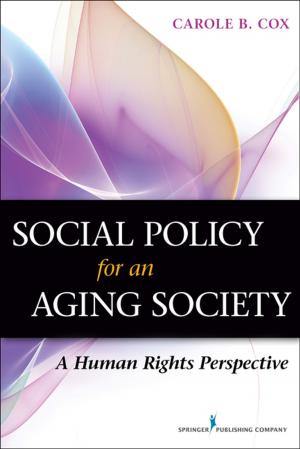The Need to Abolish the Prison System: An Ethical Indictment
Nonfiction, Social & Cultural Studies, Political Science, Government, Social Policy| Author: | Steve Martinot | ISBN: | 9781310582431 |
| Publisher: | Steve Martinot | Publication: | June 9, 2014 |
| Imprint: | Smashwords Edition | Language: | English |
| Author: | Steve Martinot |
| ISBN: | 9781310582431 |
| Publisher: | Steve Martinot |
| Publication: | June 9, 2014 |
| Imprint: | Smashwords Edition |
| Language: | English |
This book is an extended argument for the abolition of prisons as such. Its reasoning is based not on sociological considerations, such as the fact that they don’t work, but rather on ethical and political principles. I look at both the ethics that prison violates, and the ethics that society adopts in legitimizing imprisonment for itself, and how the latter violate the principles society purports to foster. In light of general consent to prisons, it becomes necessary to investigate the underlying structures that make the criminality of such punishment acceptible. These include economic exploitation, racialization and white supremacy, wars of aggression, and a general culture of contempt. These cultural structures, generally taken for granted in the US, have produced the bloated and inhumane prisonsystem that we encounter today as their logical extension. Processes of criminalization, rather than crime, are responsible for the fact that there are 2.5 million prisoners, more than any other country in the world in numbers or per capita. The need to criminalize to this extent is a sign of a profound crisis.
If we examine the act of imprisoning a person as a structure, we can dissect its various components. They are, briefly, kidnapping, torture by captivity, dehumanization (caging), and segregation (exile). These are not sociological categories. They represent a complex ethics, at the head of which is the political desire to imprison. What is not seen is the fact that these components, and others, constitute role models for the rest of society. By “role model,” I do not mean that certain acts (of violence) are rendered permissible. What a role model does, in this case, is discard the notion that something is impermissible. Murder may be illegal, but to execute a murderer is to say that killing is not impermissible. To imprison a thief is to say that kidnapping is not impermissible. To torture a person by immobilizing and assaulting their body within a confined space is to say that rape, which relies on immobilizing its victim by force or terror, is not impermissible. There are other role models of a similar kind: war, police brutality, asset forfeiture, etc.
The ethical core of imprisonment is revenge. Imprisonment enacts a revenge ethic. The person convicted of an act of violence shall suffer violence. Those who murder will be murdered. However, to respond to crime with more crime is the antithesis of justice. If justice means healing the tear in the social fabric caused by assault on another – whether on their body, their space, or their property – then a revenge ethic makes justice impossible. It doubles the criminality and the violence.
The most profound testimony to the injustice of the prison system is the victimless crime law – laws concerning drug use, drug possession, independent prostition, gambling, resisting arrest, etc.
Alternatives must be considered. These include forms of restorative justice, a radical revamping of court procedures in the direction of dialogue rather than adversarial procedure, and the immediate release of all those victimized. But the kernal of this discussion is insight into the cultural transformation necessary to make the abolition of prison thinkable, and thus make justice possible – and with it, democracy and equality.
This book is an extended argument for the abolition of prisons as such. Its reasoning is based not on sociological considerations, such as the fact that they don’t work, but rather on ethical and political principles. I look at both the ethics that prison violates, and the ethics that society adopts in legitimizing imprisonment for itself, and how the latter violate the principles society purports to foster. In light of general consent to prisons, it becomes necessary to investigate the underlying structures that make the criminality of such punishment acceptible. These include economic exploitation, racialization and white supremacy, wars of aggression, and a general culture of contempt. These cultural structures, generally taken for granted in the US, have produced the bloated and inhumane prisonsystem that we encounter today as their logical extension. Processes of criminalization, rather than crime, are responsible for the fact that there are 2.5 million prisoners, more than any other country in the world in numbers or per capita. The need to criminalize to this extent is a sign of a profound crisis.
If we examine the act of imprisoning a person as a structure, we can dissect its various components. They are, briefly, kidnapping, torture by captivity, dehumanization (caging), and segregation (exile). These are not sociological categories. They represent a complex ethics, at the head of which is the political desire to imprison. What is not seen is the fact that these components, and others, constitute role models for the rest of society. By “role model,” I do not mean that certain acts (of violence) are rendered permissible. What a role model does, in this case, is discard the notion that something is impermissible. Murder may be illegal, but to execute a murderer is to say that killing is not impermissible. To imprison a thief is to say that kidnapping is not impermissible. To torture a person by immobilizing and assaulting their body within a confined space is to say that rape, which relies on immobilizing its victim by force or terror, is not impermissible. There are other role models of a similar kind: war, police brutality, asset forfeiture, etc.
The ethical core of imprisonment is revenge. Imprisonment enacts a revenge ethic. The person convicted of an act of violence shall suffer violence. Those who murder will be murdered. However, to respond to crime with more crime is the antithesis of justice. If justice means healing the tear in the social fabric caused by assault on another – whether on their body, their space, or their property – then a revenge ethic makes justice impossible. It doubles the criminality and the violence.
The most profound testimony to the injustice of the prison system is the victimless crime law – laws concerning drug use, drug possession, independent prostition, gambling, resisting arrest, etc.
Alternatives must be considered. These include forms of restorative justice, a radical revamping of court procedures in the direction of dialogue rather than adversarial procedure, and the immediate release of all those victimized. But the kernal of this discussion is insight into the cultural transformation necessary to make the abolition of prison thinkable, and thus make justice possible – and with it, democracy and equality.















